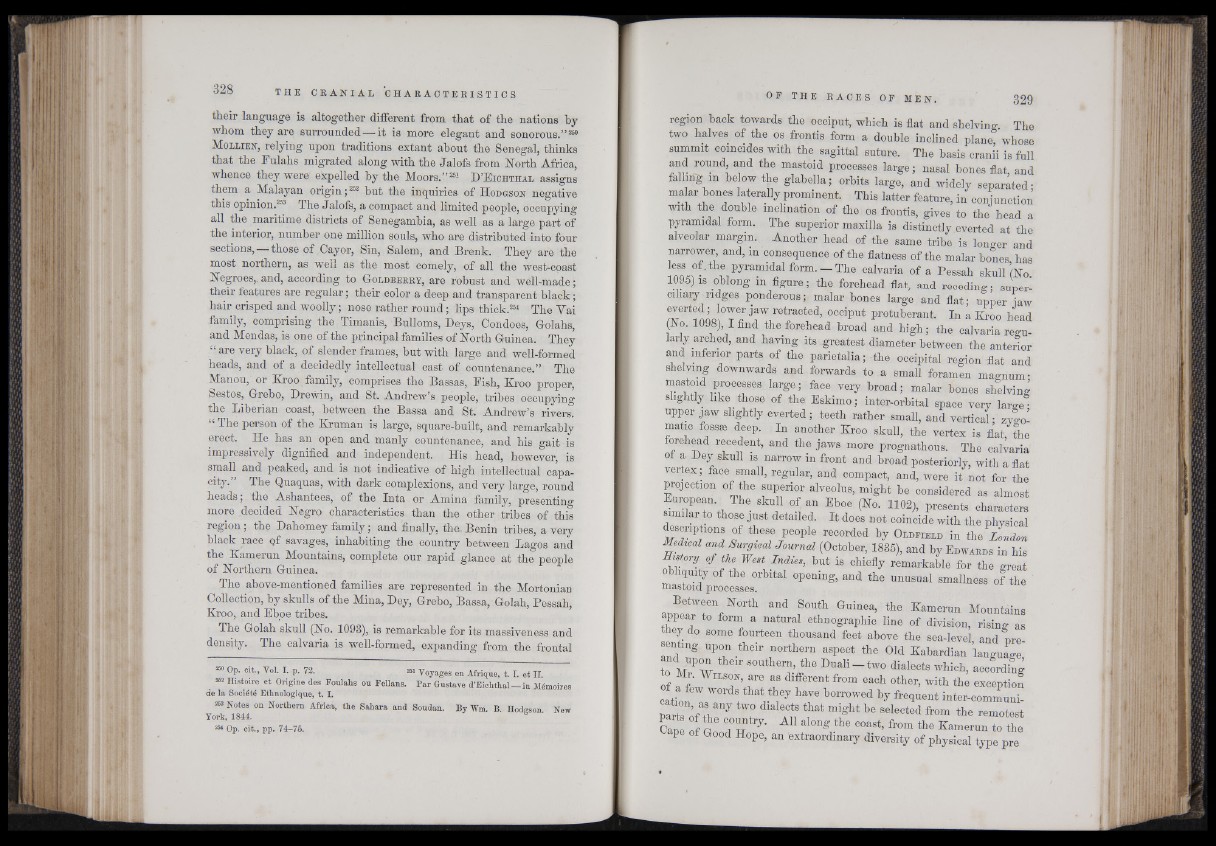
their language is altogether different from that of the nations by
whom they are surrounded — it is more elegant and sonorous.”250
M o llien, relying upon traditions extant about the Senegal, tb in k a
that the Eulahs migrated along with the Jalofs from North Africa,
whence they were expelled by the Moors.” 251 D ’E ighth al assigns
them a Malayan origin ;252 but the inquiries of H odgson negative
this opinion.253 The Jalofs, a compact and limited people, occupying
all the maritime districts of Senegambia, as well as a large part of
the intei’ior, number one million souls, who are distributed into four
sections, those of Cayor, Sin, Salem, and iircnk. They are the
most northern, as weil as the most comely, of all the west-coast
Negroes,.and, according to G oldberry, are robust and well-made;
their features are regular ; their color a deep and transparent black ;
hair crisped and woolly ; nose rather round ; lips thick.254 The Yai
family, comprising the Timanis, Bulloms, Deys, Condoes, Golahs,
and Mendas, is one of the principal families of North Guinea. They
“ are very black, of slender frames, but with large and well-formed
heads, and of a decidedly intellectual cast of countenance.” The
Manou, or Kroo family, comprises the Bassas, Pish, Kroo proper,
Sestos, Grebo, Drewin, and St. Andrew’s people, tribes occupying
the Liberian coast, between the Bassa and St. Andrew’s rivers.
“ The person of the Kruman is large, square-built, and remarkably
erect. He has an open and manly countenance, and his gait is
impressively dignified and independent. His head, however, is
small and peaked, and is not indicative of high intellectual capacity.”
The Quaquas, with dark complexions, and very large, round
heads ; the Ashantees, of the Inta or Amina family, presenting
more decided Negro characteristics, than the other tribes of this
region ; the Dahomey family ; and finally, the- Benin tribes, a Very
black race of savages, inhabiting the country between Lagos and
the Kamerun Mountains, complete our rapid glance at the people
of Northern Guinea.
The above-mentioned families are represented in the Mortonian
Collection, by skulls of the Mina, Dey, Grebo, Bassa, Golah, Pessah,
Kroo, and Eboe tribes.
The Golah skull (No. 1093), is remarkable for its massiveness and
density. The calvaría is well-formed, expanding from the frontal
260 Op- cit> Vol. I. p. 72. 351 Voyages en Afrique, t. I. et II.
; «2 Histoire et Origine des Foulahs on Fellans. Par Gustave d’Eichthal— in Mémoires
de la Société Ethnologique, t. I.
253 Notes on Northern Africa, the Sahara and Soudan. By Wm. B Hodgson New
York, 1844.
264 Op. cit., pp. 74-75.
o — .»mull ib nat ana snemng. The
two halves of the os frontis form a double inclined plane, whose
summit coincides with the sagittal suture. The basis cranii is full
and round and the mastoid processes large; nasal bones flat, and
falling m below the glabella; orbits large, and widely separated;
malar bones la erally prominent. This latter feature, in conjunction
with the double inclination of the os frontis, gives to the head a
pyramidal form. The superior maxilla is distinctly everted at the
alveolar margin. Another head of the same tribe is longer and
narrower, and, m consequence of the flatness of the malar bones has
I I u PJtamdalf0nn,~ a e eaIyaria of a Pessah skull (No
1095) is oblong m figure; the forehead fiat, and receding; superciliary
ridges ponderous; malar bones large and flat; upper iaw
M I W t f Jf I , ret; aCted’ 0cciPut Protuberant. In a Kroo head
(No. 1098) I find the forehead broad and high; the calvaria regularly
arched, and having its-greatest diameter between the anterior
and inferior parts of the parietalia; the occipital region flat and
shelving downwards and forwards to a small foramen magnum-
mastoid processes large; face veiy broad; malar bones shelving
slightly like those of the Eskimo; inter-orbital space very large
upper jaw slightly everted; teeth rather small, and vertical- zvuo-
matic fossse deep. In another Kroo skull, the vertex is flat, the
orehead recedent, and the jaws more prognathous. The calvaria
of a Dey skull is narrow in front and broad posteriorly, with a flat
vertex, face small, regular, and compact, and, were it not for the
projection of the superior alveolus, might be considered as almost
sfofokrtnA Erb0e similar to those just detailed. It doefsi n*o t 1c1o0i2n)c’i dper wesietnht st h^e rpahcytseicrasl
escrip ions of these people recorded by Ol d f ie l d in the London
Medical and Surgical Journal (October, 1835), and by E dwards in his
ittory of the West Indies, but is chiefly remarkable for the great
bliquity of the orbital opening, and the unusual smallness of the
mastoid processes.
aappnearn to^ fo“rm a n^atur afl lefthin ogGruaipnheiac’ ltihnee oKfa mdievrisuino n,M roiusinntga inass
they do some fourteen thousand feet above the sea-level and nre
seating upon their northern aspect the Old Kabardian language,
to MrPWrr lr 80 r^ tbe Duali- two diaIecte which, according
of a H T ’ ®r6 f dlfferent from eadl other, with the exception
cftion T + * tbey LaVe b0rr°Wed frequent inter-communi-
9 H H * 7 1 ® m “ ight be selected from the remotest
Cane of C Att I ^ coast, from the Kamerun to the
P °* Good H°Pe> an extraordinary diversity of physical type pre
«